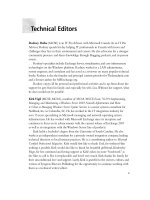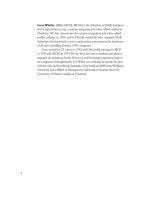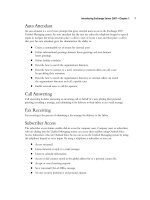Exxhange SQL And IIS- P8 docx
Bạn đang xem bản rút gọn của tài liệu. Xem và tải ngay bản đầy đủ của tài liệu tại đây (286.48 KB, 5 trang )
2 Chapter 1 • Introducing Exchange Server 2007
Introduction
This chapter gives a basic understanding of what Exchange Server 2007 is as well as an overview
of the new features and improvements included in the product. Exchange Server 2007 now uses a
role-based approach, which makes it much simpler to deploy different server roles to match the
topology of your organization. In addition, Exchange Server 2007 has moved to being a true 64-bit
application. Exchange Server 2007 also takes advantage of Windows PowerShell, making it possible
to do complex tasks in a simple and automated way using scripts. Most complicated tasks that used
to consist of several hundred lines of code can now typically be done with one line of code using
the EMS.
Finally, this chapter lists the features that have been de-emphasized and discontinued in this
version of Exchange Server 2007.
What Is Exchange Server 2007?
Exchange Server 2007 is Microsoft’s new version of the industry’s leading server software for e-mail,
calendaring, and unifi ed messaging. Exchange Server 2007 is considered the biggest upgrade in the
history of the Exchange Product group. It has been totally reengineered, and most of the code has
been completely rewritten. In addition, Exchange Server 2007 is the fi rst released Microsoft product
to take advantage of the new Windows PowerShell (formerly known as Monad) called the EMS.
The “2007” indicates the close alignment of this release with the Microsoft Offi ce 2007 wave of
products, which together deliver a best-in-class enterprise messaging and collaboration solution.
Exchange 2007 Themes
In 2003, the Exchange Product group came up with three Exchange themes aimed at refl ecting the
different types of Exchange situations. Since their introduction, the themes have stayed constant,
having played an important role during the development of Exchange Server 2007. Following is
an overview of all three themes.
IT Pro Situation
The IT Pro Situation theme focuses on making sure that Information Technology (IT) professionals
get what they need. The Exchange product team knows that e-mail is mission-critical, and that
without it, there will be a loss of productivity and revenue. They also know that current systems are
too complex and expensive, and that many of the day-to-day tasks would be better suited to scripted
automation rather than tedious manual confi guration. With Exchange Server 2007, the Exchange
product team was able to give us this control.
Info Worker Situation
The Info Worker Situation theme focuses on availability. IT professionals need access to e-mail, voicemail,
and faxes. Today, people are mobile and require access to all kinds of messaging data. With Exchange
Server 2007, the Exchange Product team can make things easier for IT professionals.
Organizationwide Situation
The Organizationwide Situation theme focuses on security and control throughout the organization’s
messaging environment. Today, e-mail needs to be secure. Filtering out spam and removing viruses
in order to provide a clean message stream needs to be a core design goal for any messaging system.
The Exchange Product group began their road to e-mail security using Exchange Server 2003
Service Pack 2, which greatly improved overall security by introducing Sender ID fi ltering and
version 2 of the SmartScreen-based Intelligent Message Filter (IMF). With Exchange Server 2007,
security has improved. Another requirement is that the messaging environment conform to legal
and corporate-wide policies, requiring us to journal, archive, and search through large amounts of
messages. Luckily, these requirements have also been improved upon and have been added to
Exchange Server 2007.
Architectural Goals with Exchange
Server 2007
When the Exchange Product group developed Exchange Server 2007 they had four main
architectural goals:
■
Simplicity Deliver a product with a simple and intuitive user interface
■
Flexibility Make the product fl exible, especially regarding deployment and management
■
Trustworthiness Secure all communication by default (OWA uses secure sockets layer
[SSL], Hub Transport Server uses Transport Layer Security [TLS], and so forth)
Scalability
Scalability is achievable by using 64-bit code (reduced input/output [I/O], more data in address
space, and so forth). The Exchange Server 2007 Product group delivered these goals. Many are
of the opinion that too many management tasks must be accomplished by running the respective
cmdlets in the EMS. Many of the management tasks missing from the Exchange Management
Console (EMC) user interface will be added into the release of Exchange Server 2007
Service Pack 1.
Role-Based Deployment and Server Roles
Unlike previous versions of Exchange, Exchange Server 2007 is easy to deploy. Although you could
dedicate an Exchange 2000 or 2003 server as either a front-end, back-end, or bridgehead server,
you always had to install all of the Exchange binaries and services even if they were not required.
Although it was possible to disable some of the Exchange Services that weren’t required, this
monolithic approach forced you to use valuable resources, disk space and/or Exchange components
you didn’t necessarily need to install.
This has all changed with Exchange Server 2007, which has a great new role-based setup wizard,
allowing you the ability to deploy individual server roles (see Figure 1.1).
Introducing Exchange Server 2007 • Chapter 1 3
4 Chapter 1 • Introducing Exchange Server 2007
Based on the new server role-based approach, you can now select what server role(s) you want
to install on a given server, thus deploying Exchange Server 2007 in a more fl exible way. Exchange
Server 2007 provides fi ve distinct server roles that include specifi c features and functionality, thereby
providing the messaging functionality you want.
Figure 1.1 Exchange Server 2007 Setup Wizard
NOTE
A server role is a unit that logically groups the required features and components
that are required to perform a specifi c function in your messaging environment.
Introducing Exchange Server 2007 • Chapter 1 5
The server roles are as follows: Client Access Server, Hub Transport, Mailbox, Unifi ed Messaging,
and Edge Transport. All server roles except the Edge Transport server can be installed on the same
physical server (typical scenario for a small organization), or distributed across multiple servers
(typical for large organizations). It depends on your organizational requirements and sometimes on
your budget.
The following sections give a short overview of each server role included in Exchange
Server 2007.
Mailbox Server Role
The Exchange 2007 Mailbox Server role hosts mailbox databases where user and resource mailboxes
are stored. This server role hosts the Public Folder database, used by organizations for the sharing of
documents, calendar, contact, and task data, as well as for archiving distribution lists. As you will see
in chapter 3, a legacy Outlook client (that is Outlook 2003 and earlier) requires a public folder
database in order to connect to Exchange Server 2007.
In addition to hosting mailbox and public folder databases, the Mailbox Server also provides rich
calendaring functionality, resource management, and offl ine address book downloads. The Mailbox
Server role also provides services that calculate e-mail address policies (called recipient policies in
Exchange Server 2000 and 2003) as well as address lists for recipients. Lastly, this server role enforces
managed folders.
The Exchange Product group also improved the high availability (HA) and recovery features for
the mailbox Server. Exchange Server 2007 includes a new continuous replication mechanism that can
be used with both non-clustered and clustered mailbox Servers. Using Structured Query Language
(SQL) technology, the new continuous replication feature uses log fi le shipping. Log fi le replay makes
it possible to replicate any changes done in the active databases to a passive copy. When speaking
about non-clustered mailbox Servers, this feature is more specifi cally known as Local Continuous
Replication (LCR), making it possible to switch to the passive copy of the database using a manual
switch. The continuous replication feature combined with Windows clustering is known as Cluster
Continuous Replication (CCR) and provides automatic failover to the passive database should the
active database fail or shutdown unexpectedly.
Client Access Server Role
The Client Access Server (CAS) role replaces the front-end. This means that the CAS provides mailbox
access for all types of Exchange clients, with the exception of Outlook MAPI clients. In a nutshell,
the CAS accepts clients accessing their mailbox using Post Offi ce Protocol version 3 (POP3), Internet
Messaging Access Protocol 4 (IMAP4), Outlook AnyWhere (formerly known as Remote Procedure
Call [RPC over HTTP], Outlook Web Access (OWA) and Exchange ActiveSync (EAS).
NOTE
The Outlook Mobile Access (OMA component is no longer a part of the Exchange
Server product.
6 Chapter 1 • Introducing Exchange Server 2007
In addition to providing client access, the CAS is also responsible for providing access to the
Offl ine Address Book (if using a Web-based distribution method), the Autodiscover service, and
the Availability service.
The Availability service is a new Web-based service providing access to the Offl ine Address Book
(OAB) and free information (housed in a public folder). In addition, Out Of Offi ce (OOF) messages
and several Unifi ed Messaging features such as Play on phone are accessed using this service.
The Autodiscover service makes is easier to confi gure Outlook 2007 and Exchange ActiveSync
clients, as end users only need to provide their e-mail address and password in order to confi gure an
Outlook or EAS profi le. If Outlook 2007 is confi gured on a workstation part of the Active Directory
domain, you don’t need to provide any information; instead you simply click Next a couple of
times and the Outlook profi le is created, using the cached credentials of the current logged on user.
(For more information about the Client Access Server role, see Chapter 5).
Hub Transport Server Role
The Hub Transport Server role is deployed inside your organization’s Active Directory. This server role
handles all internal mail fl ow and is also responsible for applying transport rules as well as journaling
policies to the respective messages fl owing through your organization. In addition, the Hub Transport
Server delivers messages to the recipient mailboxes stored on the Mailbox Server. Messages sent from
one user to another user that have their respective mailboxes stored on the same Mailbox server, use
the Hub Transport Server in order to deliver a message. This means that a Hub Transport Server must
be deployed in each Active Directory site that contains a Mailbox Server.
NOTE
Message routing in Exchange Server 2007 is no longer based on Exchange routing
groups and routing groups are no longer part of the Exchange product. Instead,
Exchange Server 2007 uses your Active Directory site topology.
A Hub Transport Server is typically only used for internal mail fl ow; however, this depends on
whether you have deployed an Edge Transport server as the Internet-facing Simple Mail Transfer
Protocol (SMTP) server in your demilitarized zone (DMZ). If you use an Edge Transport Server,
all inbound and outbound e-mail will pass through the Edge Transport Server. If you don’t want to
deploy an Edge Transport Server, you can let the Hub Transport Server act as the Internet-facing
SMTP server in your organization, although this isn’t recommended. (For more information about
the Hub Transport Server role, see Chapter 6).
Unifi ed Messaging Server Role
The Unifi ed Messaging Server role is new to the Exchange product line. This server role combines
voice messaging, fax, and e-mail into one single unifi ed inbox, making it possible to access all of
this information from a host of client solutions: Outlook 2007, Outlook Web Access 2007,
Windows Mobile 5.0, and so forth.
Unifi ed Messaging gives your end-users features like the following:









